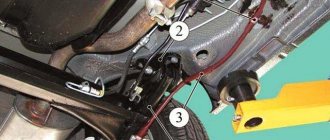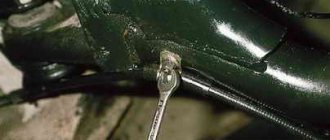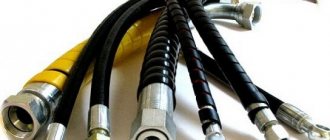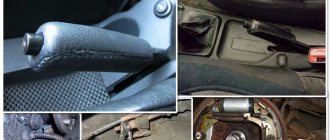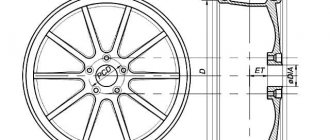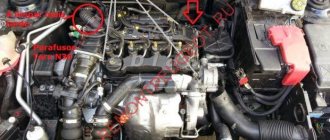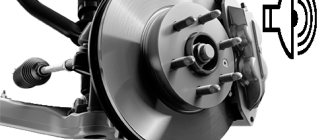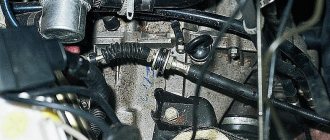Tires from Japan. Sale of wheels. Truck tires St. Petersburg. Truck tires. Buy a wheel.
How to tighten or loosen the handbrake on a VAZ 2115,2114,2113,2199,2109,2108 If the handbrake on a VAZ-2112 becomes difficult to hold, then you should not immediately change it, since the cable can be adjusted. If the mileage on the car is high, the rear pads on the car may wear out. This may reduce the effectiveness of the handbrake and the entire braking system. In this case, the handbrake cable will need to be tightened.
Replacing the handbrake cable on a VAZ-2110, 2111, 2112
The handbrake, or scientifically the hand or parking brake, is an irreplaceable part of the car, the benefits of which many people underestimate.
The handbrake is a lever that, in an unexpected situation, will help to perform emergency braking of the car, and in a difficult situation, to move away on a hill, without damaging the cars behind. Yet the main task of the handbrake is to keep the car from accidentally moving.
The handbrake makes life much easier for motorists, and sometimes even helps out. Therefore, so that a force majeure situation does not occur and the handbrake does not fail at the necessary moment, you need to monitor the condition of the cable and its serviceability.
How to identify problems with the handbrake? We list the main problems and reasons for the handbrake malfunction.
Basic malfunctions of the hand brake:
- It is difficult or completely impossible to put the car on the handbrake; the cable is difficult to move.
Reason: the threads burst in the middle and fluffed up;
- The car rolls, even with the handbrake raised.
Reason: the cable is loose;
- When I try to put the handbrake on, the car squats to one side.
Reason: one cable broke;
- The handbrake lifts too easily and the car rolls.
Reason: the cable was worn out, the threads began to break.
If a malfunction is detected, the cable should be replaced. If there is no car service nearby, arm yourself with two “13” wrenches, one “10” wrench, a wheelbrace and pliers. Go!
Video of replacing the handbrake cable
As can be seen from this description, performing the specified work is simple and accessible to almost any driver who, without going to a service station and saving a significant amount on this, wants to install a new handbrake cable or adjust the parking brake efficiently and with his own hands.
If the cable removed from the car is difficult to move in the casing, lubricate it, pour transmission or engine oil into the casing until it begins to flow out from the opposite end of the casing. During the pouring process, periodically move the cable in the sheath. Install the cable with an assistant: the lever pull is short, therefore, to install the equalizer, you need to pull the cable tightly.
Replace the cable if the following malfunctions occur: - the cable tips are loose; - the cable threads begin to tear; - the cable moves heavily in the sheath even after it has been lubricated.
Replacing the handbrake cable
1. Make sure that the car is not on the handbrake. If so, lower it. To ensure your safety and prevent the car from rolling away, put it at speed and place anti-roll bars under the front wheels.
2. Next, we tear off the wheel bolts with a wheel wrench counterclockwise, “jack up” the car and remove any of the rear wheels.
3. We unscrew the two drum bolts and, by screwing them into special holes in the drum, remove it.
4. Using pliers, remove the upper and lower springs, thereby loosening the pads, gaining access to the internal springs, by moving them aside, we can easily remove the pads.
5. Pull the cable out of the brake shield.
6. Loosen the cable holder on the beam and pull the cable out of it.
7. Move the resonator (muffler) to the side by hand; if that doesn’t work, remove the muffler.
8. Loosen the handbrake tensioner nuts (1.8). Remove from the mount (4) and lever (3).
9. Pull the cable jacket out of the equalizer and pull the cable out of the rod.
We do the same with the other wheel.
We assemble in reverse order.
Replacement results
After assembly, you should check that the cable has been replaced correctly.
To do this you need:
- Raise the rear of the car using a jack, or drive it into a viewing hole;
- Lower the lever all the way down;
- Loosen the lock nut and tighten the adjusting nut until the cable is tensioned;
- Check the clicks, the norm is from 2 to 5;
- For reliability, tighten the lock nut, holding the adjusting nut from turning.
We check the operation of the handbrake: put the car on the handbrake and rotate the wheels. The rotation should be uniform and without friction.
To be more confident, choose a steep hill (with an approximate slope of at least 25%) and put the car on the handbrake. Costs? This means the replacement was done correctly.
Why doesn't the handbrake hold (the parking brake doesn't work). Main reasons
To be honest, the handbrake or handbrake is not particularly needed in the city, especially if you have an automatic car and you have a parking mode there. Yes, and in manual mode, drivers mostly put the car in gear. Why? Yes, it’s simple - our climate is harsh, and therefore if you put on the parking brake in winter, you can get into an unpleasant situation - they will simply freeze to the rear drum brakes. However, as the traffic rules teach us, you need to set it to avoid emergency situations, for example, you left the car in neutral gear, forgot to put the handbrake on - GONE, and it rolled. It's not far from an accident! Therefore, when undergoing maintenance, this braking element must be checked; if it does not work (does not hold), then you will not pass the technical inspection. But why does this happen, what are the reasons? Let's find out...
Removing and installing components and adjusting the hand brake VAZ 2110, VAZ 2111, VAZ 2112, Lada Ten
We install the VAZ 2110 car on an inspection ditch or a lift. Removing the parking brake cable is shown using the example of the right cable. Lower the parking brake lever to its lowest position. We remove the manual brake pad drive lever from the cable end of the VAZ 2110 (see Replacing rear brake pads).
Using a 10mm wrench, unscrew the nut of the bracket securing the cable sheath to the rear suspension beam.
Remove the cable fastening bracket.
We remove the cable sheath from the holder.
Using a screwdriver, bend the three brackets securing the cable sheath to the body of the VAZ 2111.
We remove the cable from the brake shield of the VAZ 2111.
Using a wrench and a high 13mm socket, unscrew the locknut and the rod adjusting nut.
We remove the cable tip from the equalizer slot.
Remove the end of the cable sheath from the bracket.
In a similar way, we remove the left parking brake cable of the VAZ 2112. Its dismantling (unlike the right cable) is hindered by the exhaust system.
Remove the cable and equalizer.
To remove the parking brake drive lever and the adjusting rod, unscrew the two nuts from the rod and remove the equalizer (do not dismantle the cables). Remove the cover and housing of the floor tunnel lining (see Removing the VAZ 2112 instrument panel and heater air ducts).
Using a 10mm socket, unscrew the four bolts securing the lever bracket to the floor.
Using a Phillips screwdriver, unscrew the two self-tapping screws securing the parking brake warning lamp switch bracket...
...and remove the bracket with the switch.
Move the lever forward and remove it.
Unsplint the axis of the adjusting rod.
Having taken out the axle, we disconnect the adjusting rod and the lever of the VAZ 2110.
We assemble and install parts and components of the VAZ 2111 parking brake system in the reverse order.
We adjust the parking brake system of the VAZ 2112.
loosen the locknut of the tensioning device; by rotating the adjusting nut, tighten the cable; the full stroke of the parking brake drive lever should be 3-5 teeth per sector; when the lever is completely released, the wheels should rotate freely, without jamming; tighten the locknut.
A properly adjusted parking brake system should hold the vehicle on a 23% grade.
Reasons why the handbrake does not work
Often the reasons are trivial, and the work itself only takes 10 minutes (more on that a little later), but now I’ll list the main points:
- Worn rear brake pads. Usually accompanied by a grinding noise when braking. Here, tighten, don’t tighten the cable, nothing will work. First you need to replace the pads, preferably on both wheels at once, because they wear out evenly.
- Incorrectly adjusted parking brake. This also happens, the adjusting bolt is simply loose - you need to tighten it.
- Cable wedge in sheath. This often happens over time, and often appears on 5 year old or older cars. The fact is that moisture gets between the sheath and the cable itself, after which the rust and the cable get stuck in the sheath. There are two ways here, either lubricate it and develop it so that it runs normally. Or you should replace the cables with new ones.
- Broken cable. Sometimes the cable breaks, both from the handle itself and under the car, it needs to be replaced.
- Ice or salt, reagents on the surface of the pads. It happens rarely, but it does happen, especially after driving through deep puddles. It is worth cleaning the pads with gentle pressure when driving short distances. All plaque should be cleared.
- Oil or brake fluid gets on the pads. For example, the working cylinder is leaking, or the rear axle seal may be leaking. Here you first need to remove the cause of the leak, then clean the pads. Of course, they will clean themselves after several braking cycles. If the “oiling” is strong, then you need to replace the pads with new ones, because the surface of the linings can be completely saturated with oil.
I know from experience that these are mainly the first four reasons. For example, on our VAZs, very often the cable in the sheath rusts from time to time, or it breaks, and you need to tighten it in time.
Replacing the handbrake cable
1. Make sure that the car is not on the handbrake. If so, lower it. To ensure your safety and prevent the car from rolling away, put it at speed and place anti-roll bars under the front wheels.
2. Next, we tear off the wheel bolts with a wheel wrench counterclockwise, “jack up” the car and remove any of the rear wheels.
3. We unscrew the two drum bolts and, by screwing them into special holes in the drum, remove it.
4. Using pliers, remove the upper and lower springs, thereby loosening the pads, gaining access to the internal springs, by moving them aside, we can easily remove the pads.
5. Pull the cable out of the brake shield.
6. Loosen the cable holder on the beam and pull the cable out of it.
7. Move the resonator (muffler) to the side by hand; if that doesn’t work, remove the muffler.
8. Loosen the handbrake tensioner nuts (1.8). Remove from the mount (4) and lever (3).
9. Pull the cable jacket out of the equalizer and pull the cable out of the rod.
We do the same with the other wheel.
We assemble in reverse order.
Replacement results
After assembly, you should check that the cable has been replaced correctly.
To do this you need:
- Raise the rear of the car using a jack, or drive it into a viewing hole;
- Lower the lever all the way down;
- Loosen the lock nut and tighten the adjusting nut until the cable is tensioned;
- Check the clicks, the norm is from 2 to 5;
- For reliability, tighten the lock nut, holding the adjusting nut from turning.
We check the operation of the handbrake: put the car on the handbrake and rotate the wheels. The rotation should be uniform and without friction.
To be more confident, choose a steep hill (with an approximate slope of at least 25%) and put the car on the handbrake. Costs? This means the replacement was done correctly.
Hand (parking) brake system on VAZ 2110
In fact, the VAZ 2110 handbrake is quite simple. The principle of its operation is not based on anything complicated. The mechanical drive is a cable. When the parking brake handle is pulled, the driver also tightens the cable and creates uniform tension on the wheel pads.
Handbrake
If the handbrake malfunctions, it is recommended to perform an adjustment. And if it does not help, then repairs are carried out by replacing the faulty cable. On a car like the VAZ 2110, adjusting the cable is as simple as replacing it. If this malfunction is ignored, the car may move on its own, or you, on the contrary, will not be able to move.
You don’t have to go to a car service center to solve your problem. If you have some experience, understand the essence of the handbrake, and also apply the data from the repair and operation manual for the VAZ 2110, you can do everything yourself.
How to tighten and adjust the handbrake on a VAZ-2112 with your own hands (+ video)
If the handbrake on a VAZ-2112 becomes difficult to hold, then you should not change it immediately, since the cable can be adjusted. If the mileage on the car is high, the rear pads on the car may wear out. This may reduce the effectiveness of the handbrake and the entire braking system. In this case, the handbrake cable will need to be tightened.
Is adjustment necessary?
First you need to determine whether the adjustment will really solve the problem of the handbrake malfunction.
Adjusting the parking brake
To do this, a small test is carried out. Moreover, it is recommended to do a similar procedure after every 30 thousand kilometers, even if you are sure that the parking brake works well.
Drive your vehicle to an area where there is a slight slope. Place the car on it, turn on the handbrake and shift to neutral. If the car starts to roll down, everything is obvious - the handbrake needs repair.
Video about restoring the hand brake in a VAZ-2110
During the operation of the vehicle, due to wear of the rear brake pads and pulling of the drive cables, it periodically becomes necessary to adjust the travel of the parking brake lever (handbrake).
In this article we will talk about how you can tighten the handbrake on a VAZ-2110. This method can also be used when adjusting the handbrake on other front-wheel drive cars of domestic production.
- We adjust the handbrake on the VAZ-2110 with our own hands
It is also noteworthy that on the VAZ-2110 you can very easily both tighten the handbrake and replace it. If this element of the vehicle malfunctions, it is possible that the car will move on its own. The consequences of this may be very different.
This is one of the main reasons why it is necessary to periodically check the functionality of the handbrake, and if necessary, tighten it. But this does not mean at all that for this you will need to go to a car service, since you can do this yourself.
How to understand that the handbrake needs to be tightened?
It is quite easy to determine that the handbrake needs adjustment, although this is a mandatory procedure every 30 thousand km of vehicle mileage.
To do this, you need to stop on an area with a slight slope, put on the handbrake and switch to neutral gear. If the car rolls down, the parking brake does not work.
This problem can be solved by replacing the handbrake rod, but as a rule, a simple adjustment is enough.
Pulling up the handbrake
It is likely that you just need to tighten the parking brake on the VAZ 2110 to fix the problem.
- Drive to the inspection hole, from where it is most convenient to make adjustments. Another option is a lift. You'll find something here. This way you can easily get to the necessary nodes.
- Make sure the brake lever is in its lowest position.
- Take two keys. You will loosen the lock nut first and tighten the adjusting nut second.
- Tighten the adjustment nut until the cable is properly tensioned.
- It is strongly recommended to hold the rod when tightening the adjustment nut with pliers.
- Now make sure that the lever makes full travel in 2-4 clicks, no more.
- If after checking everything turned out to be good and the working stroke is correct, tighten the equalizer locknut while holding the adjustment nut with a second wrench.
- Release the handbrake lever down and turn the rear wheels by hand. Rotation should occur evenly without any jamming.
- But if the adjustment did not allow the cable to be tensioned, then the element must be replaced.
How to tighten the handbrake on a Priora - sequence of actions
Now you know how to tighten the handbrake on a Priora. We wish you success in completing these simple steps.
If the adjustment does not help
There are not many cases when adjusting the parking brake did not have any effect. However, this is no reason to despair.
It is possible that the handbrake cable has broken. This is a rare occurrence, but all options need to be considered. Especially if your VAZ 2110 is not new. By the way, on newer models the cable also breaks if the car is used very intensively. The braking system is simply not designed for such loads.
Device diagram
There are several situations in which it is necessary to replace the parking brake cable:
- The cable broke;
- The tips gave way;
- The cable threads have stretches, which over time can turn into a full-fledged rupture;
- The cable is difficult to move inside the sheath even after abundant lubrication.
The process is longer than adjustment, but not much more difficult. Therefore, you can cope with the task in your own garage with a lift or inspection hole.
There is one important condition - you will need an assistant. His task will be to pull the cable tightly, which will allow the equalizer to be installed correctly.
The sequence of work to replace the cable is as follows:
- Lower the handbrake lever as far as possible;
- Remove the brake disc from the wheel where the element is being replaced;
- Remove the muffler from the suspension cushions and the resonator from the rear suspension;
- Lower the exhaust system down;
- Remove the adjusting nut and locknut;
- Remove the equalizer;
- Now remove the cable ends from the equalizer;
- Remove the tip of the equalizer shell from the bracket, which is located on the car body;
- Bend back the brackets that secure the cable;
- Remove the rear brake pad and remove the cable end from the lever;
- Slightly loosen the nut that secures the cable holder to the rear axle;
- Remove the cable from the holder, then from the bracket, and then pull it out through the brake spike;
- Place a new cable in its new location and perform the assembly procedure, following the reverse order of the indicated processes;
- Make sure that the cables in the bracket are positioned crosswise;
- After completing the installation of the new element, adjust the handbrake.
As you can see, the task does have certain nuances, but it is not difficult at all if you have some experience and rely on the VAZ 2110 operating manual. As a rule, everything is spelled out there.
It wouldn’t hurt to supplement your skills and knowledge with video tutorials or consultation with a friend from a service station. But if you are not confident in your own abilities, you should not risk replacing the handbrake cable yourself. It is better to spend more money, but entrust the work to specialists.
If you find an error, please select a piece of text and press Ctrl+Enter.
Hand (parking) brake system on VAZ 2110
Handbrake
If the handbrake malfunctions, it is recommended to make adjustments . And if it does not help, then repairs are carried out by replacing the faulty cable. On a car like the VAZ 2110, adjusting the cable is as simple as replacing it. If this malfunction is ignored, the car may move on its own, or you, on the contrary, will not be able to move.
You don’t have to go to a car service center to solve your problem. If you have some experience, understand the essence of the handbrake, and also apply the data from the repair and operation manual for the VAZ 2110, you can do everything yourself.
Signs of a malfunction of the VAZ 2110 hand brake
There are a number of signs that indicate a malfunction of the parking brake system. We list the main ones:
- When the handbrake is pulled on, the rear wheels spin and the car rolls down the hill. The cable is probably loose and needs to be tightened.
- When the handbrake is weakened, the rear wheels jam. This indicates frozen (in winter) or worn out pads. There is also a high probability of a faulty return spring.
- When driving, you can hear squeaks from the rear wheel drums. As in the previous case, the pads jam.
- One of the wheels is blocked and does not rotate (goes skidding). In this case, a spring malfunction is excluded - the problem is inside the drum in one of the wheels.
In most cases, it is enough to adjust the brakes, since the cable tends to stretch and sag. It is also not uncommon to encounter a malfunction inside the drums themselves due to their vulnerability to external factors.
Is adjustment necessary?
First you need to determine whether the adjustment will really solve the problem of the handbrake malfunction.
Adjusting the parking brake
To do this, a small test is carried out. Moreover, it is recommended to do a similar procedure after every 30 thousand kilometers, even if you are sure that the parking brake works well.
Pulling up the handbrake
It is likely that you just need to tighten the parking brake on the VAZ 2110 to fix the problem.
- Drive to the inspection hole, from where it is most convenient to make adjustments. Another option is a lift. You'll find something here. This way you can easily get to the necessary nodes.
- Make sure the brake lever is in its lowest position.
- Take two keys. You will loosen the lock nut first and tighten the adjusting nut second.
- Tighten the adjustment nut until the cable is properly tensioned.
- It is strongly recommended to hold the rod when tightening the adjustment nut with pliers.
- Now make sure that the lever makes full travel in 2-4 clicks, no more.
- If after checking everything turned out to be good and the working stroke is correct, tighten the equalizer locknut while holding the adjustment nut with a second wrench.
- Release the handbrake lever down and turn the rear wheels by hand. Rotation should occur evenly without any jamming.
- But if the adjustment did not allow the cable to be tensioned, then the element must be replaced.
Adjusting the hand brake
Adjustment is also necessary in cases where the handbrake operates before the lever makes a second click.
This means that when fully loaded, the rear brakes will slow down the wheels , the drums will overheat, fuel consumption will increase, and the pads will wear out intensively. To adjust, we will need to get two 13mm wrenches, pliers and, just in case, find a penetrating lubricant like WD-40 .
It will be needed to remove rusted, possibly adjusting or locking nuts. Further work is carried out in this order:
- We place the car on an overpass or inspection hole, since with the wheels hanging out we will not be able to accurately adjust the handbrake.
If there is no hole nearby, you can drive the car onto such a mini overpass. - We lower the parking brake lever all the way, after first lifting it all the way up several times.
Lower the lever all the way. - We go down under the car and thoroughly clean the tensioner mechanism from dust and dirt.
If necessary, treat the threads of the handbrake cable rod with aerosol lubricant. In the arch behind the muffler we find the adjustment unit and clean it of dirt. - We loosen the lock nut with a 13 wrench, holding the nut for adjustment with a second wrench.
1 – lock nut, 2 – adjusting nut, 3 – rod, 4 – equalizer. - Using the adjusting nut, tighten the cable until the cable is taut.
If the nuts are hard to move, spray more lubricant. - We check the cable tension with the full stroke of the handbrake lever: it should rise above the fourth click.
We go into the salon, pull the lever and count the clicks. - If everything is fine, tighten the locknut on the cable rod, holding the adjusting nut with a second wrench.
- We lower the brake lever all the way and check the rotation of the wheels - they should rotate freely, the pads should not touch the drums at this time.
If during adjustment we were unable to reduce the number of clicks to four, feel free to change the handbrake cable or check the condition of the brake pads and drums. Good luck to everyone and strong brakes!
If the adjustment does not help
There are not many cases when adjusting the parking brake did not have any effect. However, this is no reason to despair.
Device diagram
There are several situations in which it is necessary to replace the parking brake cable:
- The cable broke;
- The tips gave way;
- The cable threads have stretches, which over time can turn into a full-fledged rupture;
- The cable is difficult to move inside the sheath even after abundant lubrication.
There is one important condition - you will need an assistant. His task will be to pull the cable tightly, which will allow the equalizer to be installed correctly.
The sequence of work to replace the cable is as follows:
- Lower the handbrake lever as far as possible;
- Remove the brake disc from the wheel where the element is being replaced;
- Remove the muffler from the suspension cushions and the resonator from the rear suspension;
- Lower the exhaust system down;
- Remove the adjusting nut and locknut;
- Remove the equalizer;
- Now remove the cable ends from the equalizer;
- Remove the tip of the equalizer shell from the bracket, which is located on the car body;
- Bend back the brackets that secure the cable;
- Remove the rear brake pad and remove the cable end from the lever;
- Slightly loosen the nut that secures the cable holder to the rear axle;
- Remove the cable from the holder, then from the bracket, and then pull it out through the brake spike;
- Place a new cable in its new location and perform the assembly procedure, following the reverse order of the indicated processes;
- Make sure that the cables in the bracket are positioned crosswise;
- After completing the installation of the new element, adjust the handbrake.
As you can see, the task does have certain nuances, but it is not difficult at all if you have some experience and rely on the VAZ 2110 operating manual. As a rule, everything is spelled out there.
It wouldn’t hurt to supplement your skills and knowledge with video tutorials or consultation with a friend from a service station. But if you are not confident in your own abilities, you should not risk replacing the handbrake cable yourself. It is better to spend more money, but entrust the work to specialists.
Main causes of failure
The main reason why such an important device may break and need to be replaced is mechanical wear of the handbrake. As you know, the basis of the system is a small cable that transmits forces from the lever to the mechanism
It actually turns on this node.
The operating conditions of the cable are quite complex - the constant load from the force that the driver transmits through the handbrake lever to the system, sooner or later, can damage the device.
However, the cable breaks extremely rarely - most often, the cables simply jump off. Or the tips fixed in the drum are ground with very long wheel bolts. Needs renovation. Also, the parking brake may not work due to wear on the rear drum brakes (as well as abrasion of the pads, depending on the design).
As a result, the unit ceases to perform the functions assigned to it - the handbrake simply does not hold. The parking brake needs to be replaced and subsequently adjusted. But not everything is so simple - in some cases, the device can be damaged during emergency braking of the car - as a result, it will require repair or replacement.
Often the metal is not completely ground, but the steel fibers are stretched and moving in the shell is very difficult
But it doesn’t matter what the reason for the parking brake failure is, why it doesn’t hold. The purpose of our article is to figure out how to solve the problem

